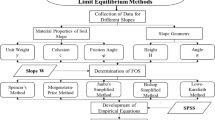Conclusions
-
1.
Slope stability analyses based on methods which do not examine the stress—strain state of the fill as a whole, including use of both the strength and deformability of the soils, do not guarantee actual slope stability in all cases.
-
2.
The shape of the collapse surface depends on the mechanical properties of the soils and also on the fill height. The numerical method of analysis showed, in all the cases examined, the flattest collapse-surface outline.
-
3.
The stability factor of safety depends on the stress-strain state of the structure as a whole and, therefore, in computing its values, of great importance are the fill height, crest width, dilatancy, variation of deformational characteristics and soil strength with the ratio between the principal stresses, and the stage-by-stage pattern of the loading.
-
4.
The soil strength and deformability data obtained in a stabilometer are found to be insufficient for determining the stability factor of safety with a satisfactory accuracy.
Similar content being viewed by others
Literature Cited
Earth Dams, Construction Standards and Regulations [in Russian], SNiP II-53-73.
A. L. Kryzhanovskii, V. A. Zaziyants, and E. F. Gul'ko, “Rational soil model in calculating fills in two- and three-dimensional formulation,” Gidrotekh. Stroit., No. 1 (1976).
A. I. Botkin, Strength of Cohesionless and Brittle Materials [in Russian], Bulletin of the B. Vedeneev All-Union Scientific-Research Institute of Hydraulic Engineering (VNIIG), Vol. 26 (1940).
Foundations of Buildings and Structures [in Russian], SNiP II-15-64.
S. S. Grigoryan and V. A. Ioselevich, Soil Mechanics. Soil Mechanics in the USSR during 50 Years [in Russian], Vol. 3, Izd. Akad. Nauk SSSR (1972).
V. A. Florin, Fundamentals of Soil Mechanics [in Russian], Vol. 11, Stroiizdat, Leningrad (1961).
A. A. Nichiporovich, Embankment Dams [in Russian], Énergiya, Moscow (1973).
R. R. Chugaev, Hydraulic Structures of Earth Construction [in Russian], Énergiya, Moscow (1967).
A. L. Kryzhanovskii, R. V. Artemov, E. F. Gul'ko, V. A. Zaziyants, A. S. Chevikin, and O. V. Kulikov, “Improvements in analysis of stress — strain state of embankment dams,” in: Summaries of Papers, All-Union Conference on Methods of Determining Stressed State and Stability of High-Head Hydraulic Structures and Their Foundations, Subjected to Static and Dynamic Loadings [in Russian], V. V. Kuibyshev Moscow Institute of Civil Engineers, Moscow (1972).
V. V. Sokolovskii, Statics of Noncohesive, Medium [in Russian], Fizmatgiz, Moscow (1960).
N. N. Maslov, Conditions for Stability of Slopes and Batters in Hydrotechnical Construction [in Russian], Gosénergoizdat, Moscow (1955).
M. N. Gol'dshtein and S. S. Babitskaya, “Slope stability analysis allowing for shear creep,” in: Problems in Geomechanics, No. 7 (1964).
M. N. Gol'dshtein and G. I. Ter-Stepanyan, “Long-term strength of clays and slope creep at depth,” in: Papers of the Fourth International Congress on Soil Mechanics and Foundation Engineering [in Russian], Izd. Akad. Nauk SSSR (1957).
Additional information
Translated from Gidrotekhnicheskoe Stroitel'stvo, No. 5, pp. 38–44, May, 1977.
Rights and permissions
About this article
Cite this article
Kryzhanovskii, A.L., Kulikov, O.V. Computation of slope stability. Hydrotechnical Construction 11, 504–513 (1977). https://doi.org/10.1007/BF02403604
Issue Date:
DOI: https://doi.org/10.1007/BF02403604




